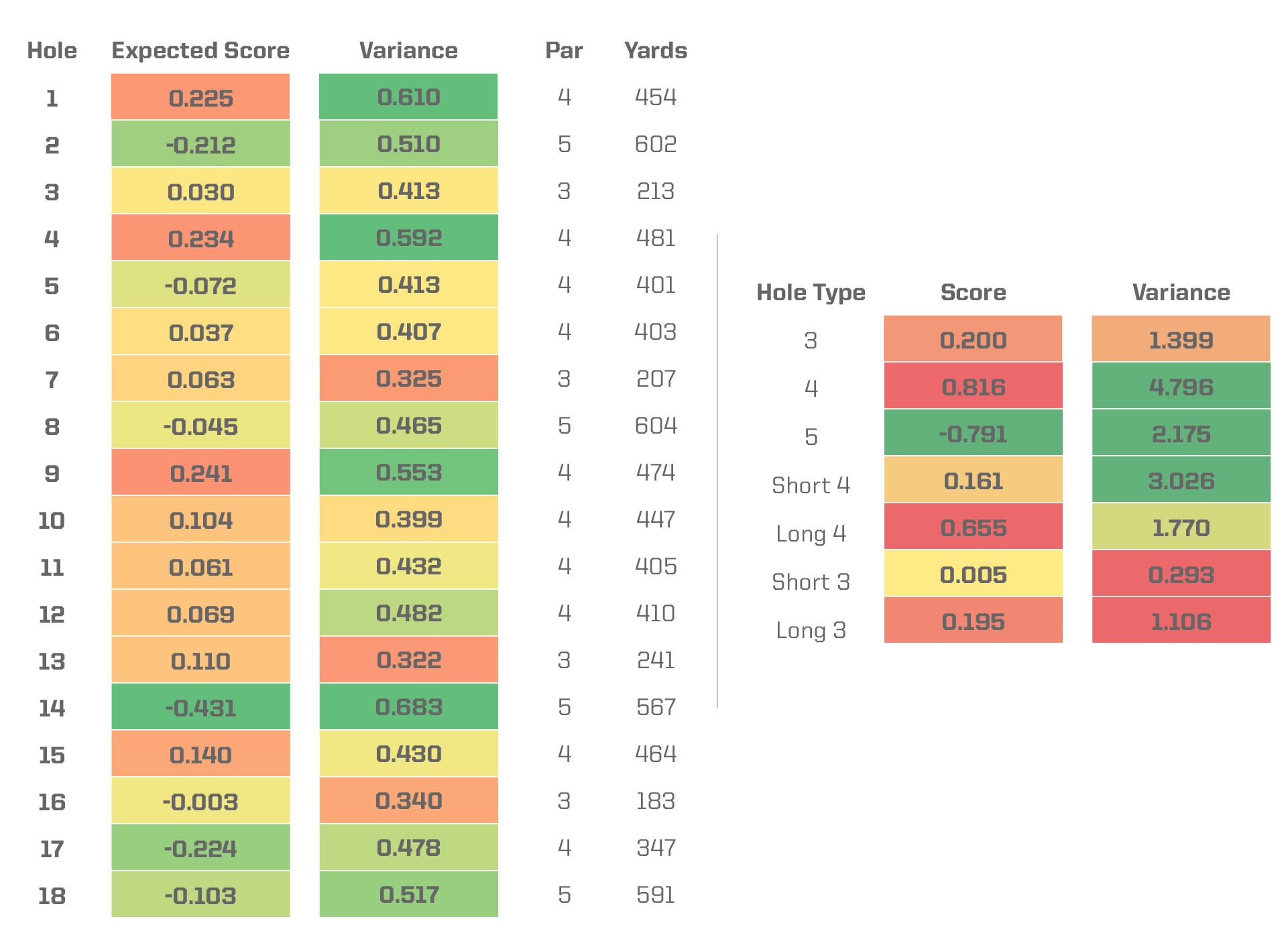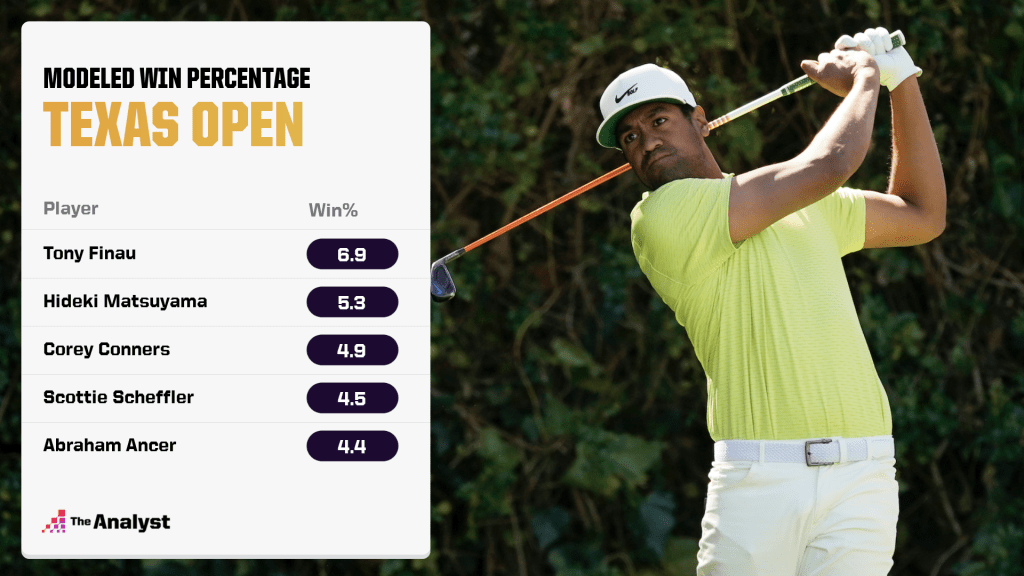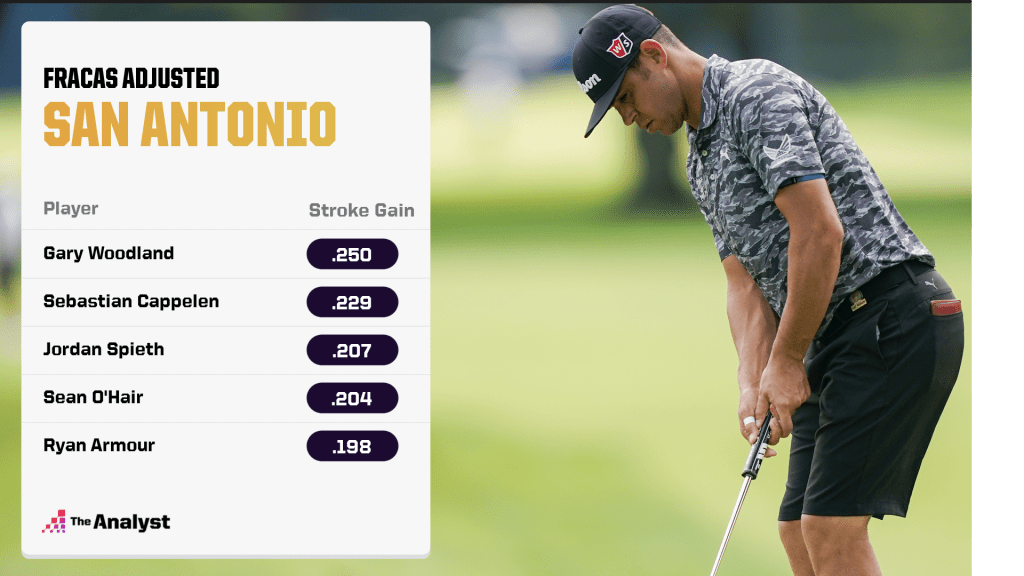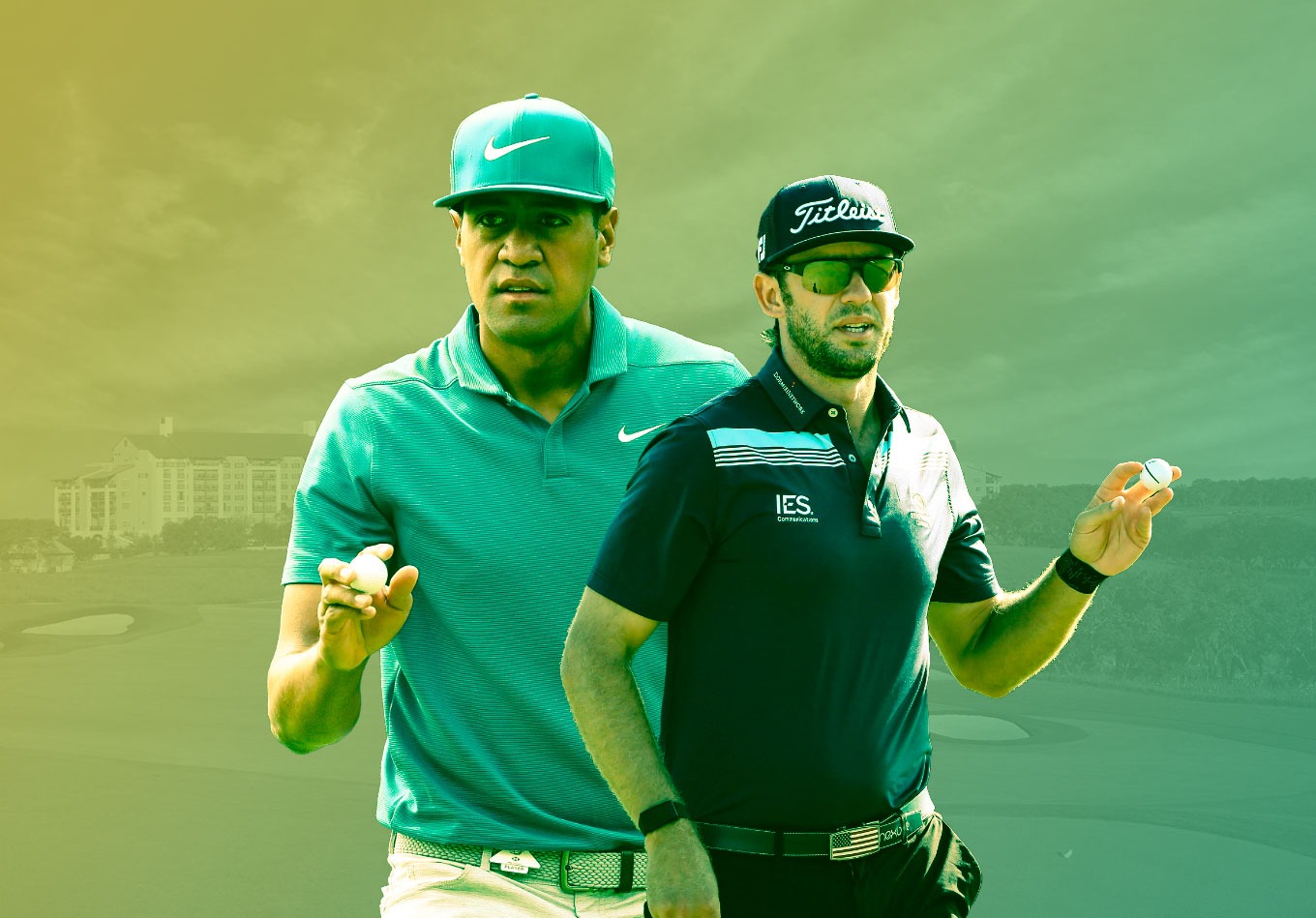We’re back, and we have some new toys.
We’ve introduced FRACAS, a course-specific golf model designed to establish a standardized player ranking system.
In our tournament previews you’ll see FRACAS referenced when discussing golfers and field strengths, and in a future installment we’ll explain how we use FRACAS to simulate tournaments. For now, let’s get into the Valero Texas Open.
The Tournament
The Valero Texas Open was cancelled in 2020 as part of the COVID break, but the pre-Masters tournament returns in 2021. Hosted by TPC San Antonio on the Oaks Course, the tournament typically plays rather difficult. Though recent winners have posted scores in the upper teens, traditionally the winner scores between 12- and 16-under par with a cut-line right around even par.
Designed by Greg Norman with input from Sergio Garcia, the Oaks Course is a long par 72 playing up to 7,500 yards on paper, and can play longer if the wind is up. The length comes primarily from three par 3s playing over 200 yards and three par 5s playing over 600 yards.
The par 4s aren’t terribly long, with just four of them playing over 450 yards. Though they aren’t terribly long, the 10 par 4s on the course do play almost a stroke over par, so bogey-avoidance on the par 4s and par 3s while making strokes up on the par 5s is how to win this tournament.

The Field
Though not the strongest of fields, the Texas Open has 34 of our top 100 golfers in the field, per FRACAS. The average golfer in this field would lose 0.33 strokes per round in an average PGA Tour event. Last week, the field at the Corales Punta Cana lost an average of 1.01 strokes, while THE PLAYERS field gained an average of 0.50 strokes. So again, not the strongest field, but certainly a step up from an alternate field event like Corales Punta Cana. With 144 players in the field, it does play a bit trickier than the 120-player tournaments we’ve seen a bit of in the early season.
Using course-specific FRACAS, there are a few top players who gain some value playing at the Oaks. Jordan Spieth is the biggest gainer of our top 10 players, gaining 0.207 strokes per round at this course compared to an average tour course. Spieth plays his best on long par 3s, short par 4s, and par 5s – perfect for this tournament. The biggest gainer is Gary Woodland, who matches Spieth almost exactly in how he puts up scores.
The Picks
Let’s first talk a little about how we’re making these picks. While we haven’t revealed the methodology behind our simulations yet, we do simulate tournaments 100,000 times to get distributions of outcomes for each golfer. These can be turned into odds, which we’ll then compare to industry averages. These averages come from aggregating the odds from the top sportsbooks in the world. We’ll note that these odds are constantly moving, so please be aware that if we reference Jordan Spieth’s 11-1 industry odds, those are his odds at the time of publication.
When we discuss a player, we’re almost certainly identifying a player who we feel has a better chance to win than the consensus oddsmakers believe. We’ll include our top five modeled win percentages each week to avoid some confusion, but in most cases, those top five will have consensus odds worse than our modeled odds, and we are by no means recommending a bet on those players.
For instance, this week our top projected win percentage belongs to Tony Finau, who we believe has a 6.9% chance to win, or about 14.5-1. His consensus odds are 13-1, meaning the sportsbooks think he has about a 7.7% chance to win. Even though he’s our pick to win the tournament, his projected win percentage is lower than the odds being offered. This means if you were to place a wager on Finau, we would expect you to return negative value on that bet, and would not recommend it.

Let’s discuss some players who we feel are being underrated. Lanto Griffin is the first such player. The consensus odds have Griffin at about 44-1 to win the tournament, while our model projects about 33-1 to win. By FRACAS, we have Griffin as the 38th player in the world and eighth best in this tournament, but he’s being priced as the 14th best.
The model’s love for Griffin this week comes from his proficiency on long holes. He’s projected for seventh in the field in long par 3 strokes gained, fourth in long par 4s strokes gained, and 14th in par-5 scoring. His scoring on difficult par 4s will come in handy this week given the difficulty we mentioned in the course overview. If Griffin plays the par 4s at even par or a little better, while stealing a birdie or two on the long par 3s and scoring even field average on the par 5s, he should be in contention come Sunday.
Sticking with our trend of long par-3 scoring being the key this week, Gary Woodland is another golfer who has to be considered underrated. Though not in his finest form since being sidelined with a hip injury in fall of 2020, Woodland was showing signs of improvement before testing positive for COVID ahead of the Honda Classic.
FRACAS has dropped him out of the top 50 in the world, but this course fits Woodland to a T. As we’ve mentioned, Woodland gains the most from TPC San Antonio than any other golfer in the field, per FRACAS. He’s projected to lead the field in long par-3 scoring where he could gain 1.72 strokes over four days, should he make the cut. The consensus odds put him at 68-1, but our simulator believes he should be more like 40-1.

Looking into the golfers who have triple-digit odds, there are a few who tickle our fancy. Austrian Bernd Wiesbergeris the first longshot we’ll take a look at. With consensus odds at 117-1, our model says he should be 75-1. A full member of the European Tour, Wiesberger uses his status as a top-50 player by OWGR to gain exemptions into a handful of PGA tournaments.
Currently sitting at 47th in the world, he’s already booked his ticket to Augusta next week. But 47th is a precarious position and Wiesberger will be looking to solidify his top-50 status. He’s as consistent as they come despite not really excelling at any particular type of hole, and doesn’t have any glaring weaknesses. If he wins this week, it will more likely be a result of four consecutive rounds of 4-under par than it will be two rounds in the low-mid 60s.
Jim Furyk could follow the same path to victory this week. He modeled as the 28th most likely to win this week at 79-1, while the consensus odds put him at 128-1. Though he’s only 28th in win equity, we have him as 16th most likely to make the cut. That’s a testament to his consistency. There are holes at TPC San Antonio where you can put up some ugly numbers, and Furyk just isn’t likely to do that. He won’t win any birdie-fests, but courses where saving par and fighting to stay in the red is where players like the 50-year-old Furyk thrive.
Our final player to highlight is Charl Schwartzel. Schwartzel is a former Masters champion and has won on half a dozen different world tours, but he hasn’t had a win since 2016. We don’t really expect him to win this week, where the model projects his odds to be about 100-1, but his consensus odds are hovering around 150-1 and can be sound at 200-1 or lower. Short par 3s are Schwartzel’s biggest weakness, but with just one moderately short par 3 this week, Schwartzel could use par-5 scoring to contend. He plays par 5s well, and tends to save par on difficult par 4s, ranking inside the top 25 in the field for both hole types.
DraftKings GPP Plays
Our simulation model also simulates DraftKings results. This is an important distinction, as DraftKings points are driven both by finishing position and hole scoring. So players like Finau, who makes a lot of birdies while also making some bogeys, may be a better DraftKings play than golfers like Charles Howell III, who has a great chance to make the cut but doesn’t score much.
We’ll go through each salary grouping and identify players we see as being underpriced relative to player value and those who are around them. Generally we’ll identify around 20 players we like, though that number can change depending on the size of the field.
This week we don’t find any players returning projected negative value until $7,500, so while we’re picking our favorites of each range, the top groups are all viable plays.
The $10,000s and Up
Dustin Johnson’s withdrawal made this area a bit thinner and we’ll be quick about it. With just four options and a highest price of $11,000 rather than $11,800, we like Finau and Hideki Matsuyama. Spieth should be popular, and he’s been trending upwards, but FRACAS still does take into account some of his recent struggles. He’s still too volatile for our liking. We’d rather pay for Finau, who is the poster boy for good DraftKings plays.
- Tony Finau ($11,000)
- Hideki Matsuyama ($10,100)
The $9,000s
Kind of a weird range this week. Brendan Steele and Charley Hoffman are players the model immediately recognizes as overpriced relative to the other five, but Matt Kuchar and Cameron Tringale aren’t too far behind. Overall, it’s not really close between Ancer, Conners, and Ryan Palmer over the other four, and those three are our comfortable picks in this range.
- Abraham Ancer ($9,700)
- Corey Conners ($9,500)
- Ryan Palmer ($9,400)
The $8000s
- Lanto Griffin ($8,700)
- Keegan Bradley ($8,400)
- Sam Burns ($8,000)
The $7,000s
Finally a range with a substantial number of players we can differentiate a little. Woodland is far and away our favorite play from this range, and frankly we’re a little baffled he’s so cheap. With enough players, we can start to pick out players based on both their projected scores and the players around them. In this range, there are seven golfers who should return positive value and are in the 90th percentile of their range.
- Gary Woodland ($7,600)
- Sebastian Munoz ($7,600)
- Erik Van Rooyen ($7,500)
- Adam Long ($7,200)
- Bernd Wiesberger ($7,200)
- Luke List ($7,000)
- Tom Hoge ($7,000)
The $6,000s
Occasionally, we’ll find no value at all in this range, but this week we have four golfers who fit our low-priced criteria. Lee and Hoag in particular are at a low enough price to allow you to really stack the top of your lineups, and we think each has not only the potential to make the cut, but to finish relatively strong.
- Jim Furyk ($6,800)
- Charl Schwartzel ($6,700)
- Danny Lee ($6,500)
- Bo Hoag ($6,400)
Design by Matt Sisneros.
